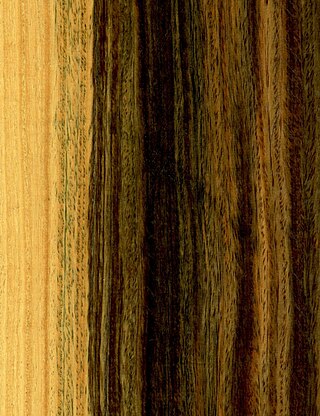
Lignum vitae, also called guayacan or guaiacum, and in parts of Europe known as Pockholz or pokhout, is a wood from trees of the genus Guaiacum. The trees are indigenous to the Caribbean and the northern coast of South America and have been an important export crop to Europe since the beginning of the 16th century. The wood was once very important for applications requiring a material with its extraordinary combination of strength, toughness, and density. It is also the national tree of the Bahamas, and the Jamaican national flower.

The mouflon is a wild sheep native to Cyprus, and the Caspian region, including eastern Turkey, Armenia, Azerbaijan, Georgia and Iran. It is also found in parts of Europe. It is thought to be the ancestor of all modern domestic sheep breeds.
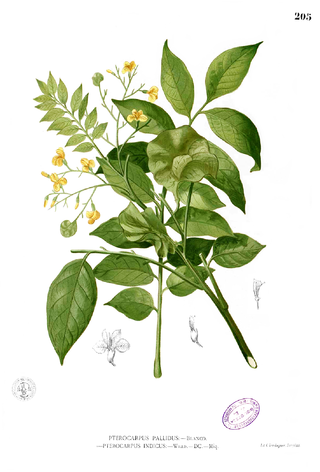
Pterocarpus indicus is a species of Pterocarpus native to southeastern Asia, northern Australasia, and the western Pacific Ocean islands, in Cambodia, southernmost China, East Timor, Indonesia, Malaysia, Papua New Guinea, the Philippines, the Ryukyu Islands, the Solomon Islands, Thailand, and Vietnam.

Gmelina arborea,, locally known as gamhar, is a fast-growing deciduous tree in the family Lamiaceae.

Bulnesia sarmientoi is a tree that inhabits a part of the Gran Chaco area in South America, around the Argentina-Bolivia-Paraguay border. Its wood is often traded as "Paraguay lignum vitae", since it has properties and uses similar to the "true" lignum vitae trees of genus Guaiacum, which are close relatives. Another trade name is "vera" or "verawood", which may also refer to the even more closely related B. arborea. Another common but rather ambiguous name is palo santo, which it shares with the species Bursera graveolens.

Endoclita is a genus of moths of the family Hepialidae. There are 60 described species found in eastern and southeast Asia and the Indian subcontinent.

Guaiacum officinale, commonly known as roughbark lignum-vitae, guaiacwood or gaïacwood, is a species of tree in the caltrop family, Zygophyllaceae, that is native to the Caribbean and the northern coast of South America.

Vitex is a genus of flowering plants in the sage family Lamiaceae. It has about 250 species. Common names include chaste tree or chastetree, traditionally referring to V. agnus-castus, but often applied to other species, as well.
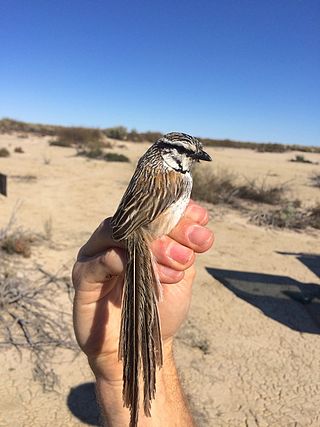
The grey grasswren is a passerine bird in the Australasian wren family, Maluridae. It is found on arid inland floodplains of Australia where it is endemic. The grey grasswren is a rarely seen elusive bird that was first sighted in 1921 but not taxonomically described until 1968. Its greyish coloration and very long tail distinguish it from all other grasswrens. While some recent research has been conducted, there still remain many gaps in the knowledge about the ecology of this cryptic bird.
Gmelina hainanensis is a species of tree in the family Lamiaceae. It is a medium-sized tree, up to 15 metres (49 ft) tall, growing on open grassy hillsides and sparse forests. It is found in southern China and in Vietnam.
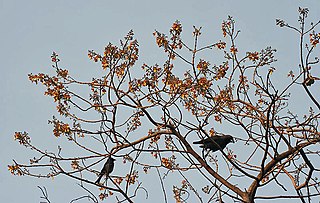
Gmelina is a genus of plants in the family Lamiaceae. It consists of about 35 species, native to Australia, Southeast Asia, India, New Guinea and New Caledonia. Some species such as G. arborea have been planted and/or become naturalised in India, Africa and Australia. It was named by Carl Linnaeus in honour of botanist Johann Georg Gmelin.
Gmelina vitiensis is a species of plant in the family Lamiaceae. It is endemic to Fiji.
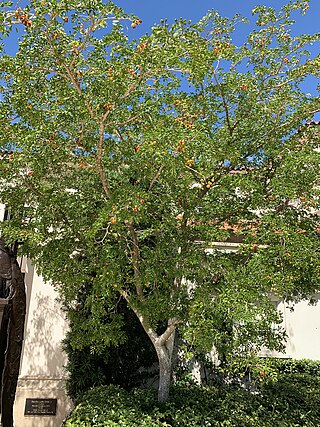
Guaiacum sanctum, commonly known as holywood, lignum vitae or holywood lignum-vitae, is a species of flowering plant in the creosote bush family, Zygophyllaceae. It is native to the Neotropical realm, from Mexico through Central America, Florida in the United States, the Caribbean, and northern South America. It has been introduced to other tropical areas of the world. It is currently threatened by habitat loss in its native region, and as such, is currently rated near threatened on the IUCN Red List. Guaiacum sanctum is the national tree of the Bahamas.

Guaiacum angustifolium is a species of flowering plant in the caltrop family, Zygophyllaceae. Common names include Texas guaiacum, Texas lignum-vitae, soapbush and huayacán. It is native to southern and western Texas in the United States and northern Mexico. The specific name is derived from the Latin angustus, meaning "narrow," and -folius, meaning "-leaved".
Lignum is Latin for wood and may refer to:

Caecum vitreum is a species of minute sea snail, a marine gastropod mollusk or micromollusk in the family Caecidae.
Gmelina is a genus of crustaceans of the family Gammaridae, containing two species:

Gmelinol is a lignan. (+)-Gmelinol can be isolated from the heartwood of Gmelina arborea. This compound, along with four other chemicals also found in the same species, (+)-7′-O-ethyl arboreol, (+)-paulownin, (+)-epieudesmin and (−)-β-sitosterol, shows antifungal activity against Trametes versicolor.
The glassy darter is a species of freshwater ray-finned fish, a darter from the subfamily Etheostomatinae, part of the family Percidae, which also contains the perches, ruffes and pikeperches. It is found from the Bush River in Maryland to Neuse River in North Carolina. It inhabits sandy runs of creeks and small to medium rivers. This species can reach a length of 6.6 cm (2.6 in), though most only reach about 4.7 cm (1.9 in).

Distomus is a genus of ascidian tunicates in the family Styelidae.















